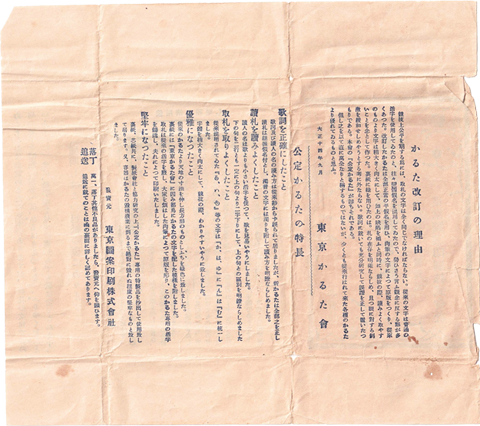The appearance of Official Karuta
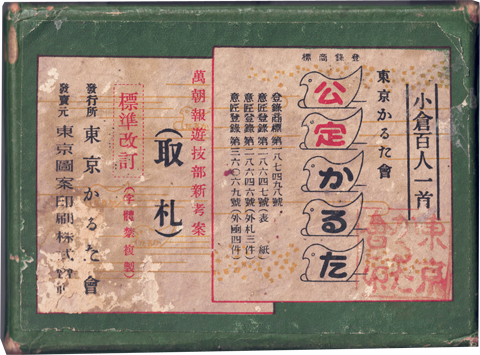
Standard Revised Official Karuta
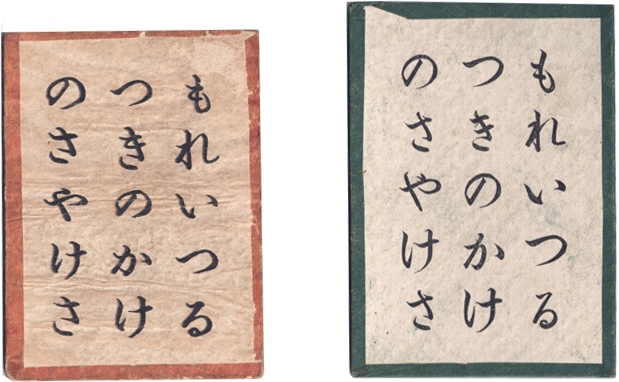
Difference between standard and official sizes
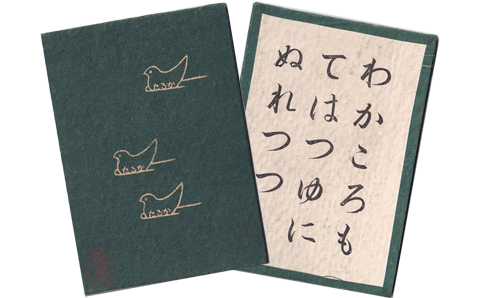
On the back of the card is a design of birds
called "Miyakodori"
In 1925, "Standard Revised Official Karuta" (with the mark of the bird on the back of the card), which was greatly revised by Hideo Kuroiwa, son of Ruiko Kuroiwa (who died in 1920), was released by Tokyo Zuan Printing.
"Instruction Manual for Official Karuta"
Also, Karuta cards appeared in magazine appendix*. Hyakunin Isshu Karuta cards had spread throughout Japan. At that time, in addition to cards for Kyogi karuta, many Karuta distributor produced and sold cards called "practice Karuta cards". Each of the karuta distributor had their own "Teihon" that they relied on. Therefore, the notation was different from that of the cards for Kyogi karuta.
*There is no record of the circulation of the New Year issue of the magazine "Shojo no Tomo" in 1934. However, based on the records of "Shoujo Club," a rival magazine at the time, it probably had a circulation of about 300,000.
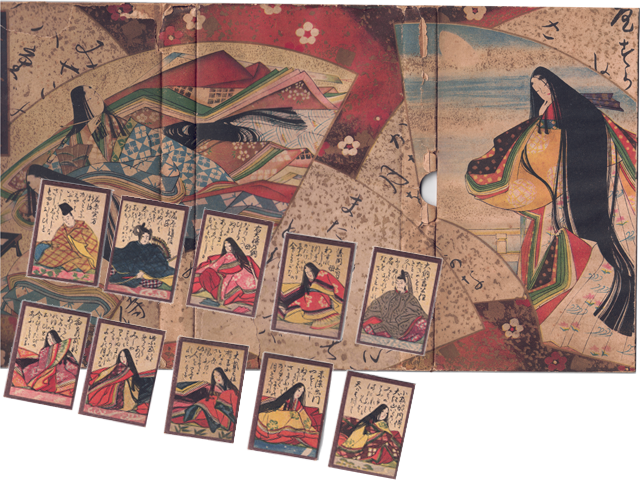
Appendix of the New Year issue
of the magazine "Shojo no Tomo" in 1934
Karuta in time of war
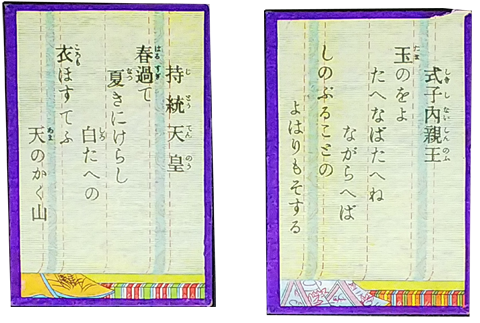
Misu-gakure karuta
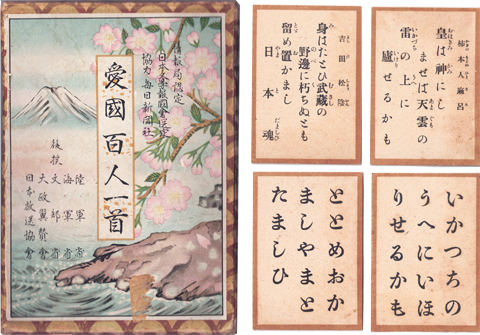
Aikoku Hyakunin Isshu
In 1941, it is said that the so-called "Misu-gakure karuta", in which the pictures of the emperor and the imperial family are hidden by a blind, was recommended on the grounds that "it is disrespectful to play with the emperor and the imperial family depicted in the Hyakunin Isshu.
Furthermore, after 1942, competition karuta was refrained from because of the many love poems in Hyakunin Isshu.
Instead, they used the "Aikoku Hyakunin Isshu(One Hundred Poems of Patriotism)," which was recommended by the government, and barely continued to compete.
When the Kempeitai(the military police) learned that there were Ogura Hyakunin Isshu enthusiasts groups all over Japan, the groups were strongly criticized, saying, "What is the matter with playing with love poems at a time of national emergency? "
Our association had no choice but to think it over, and after much deliberation, we brought the " Aikoku Hyakunin Isshu (selected by the Japan Literature Association for the sake of the nation and approved by the Information Bureau) " to the Kempeitai and submitted it to them with trepidation. Then the Kempeitai were very pleased and told us to spread it around a lot.
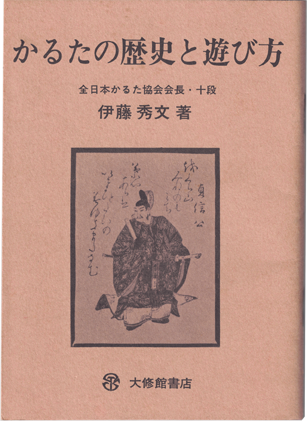
With the encouragement of the Kempeitai our association held the "First Aikoku Hyakunin Isshu Tournament" at the Kashihara Shrine. However, the venue was later destroyed by fire and the players dispersed. For a while, there was no one to look back on the Kogi karuta.
From "The History of Karuta and How to Play"
Written by Hidefumi Ito
Revival of Kyogi karuta
After World War II, the activities of karuta associations began to resume in many places.
And although the exact timing is unknown, Kyogi karuta cards were manufactured by two karuta dealers, "Seibunkan" in Kanto and "Oishi Tengu-do" in Kansai.
The Karuta cards produced by Seibunkan used the same notation as the revised "Kotei-karuta(Standard Revised Official Karuta )". On the other hand, Oishi Tengu-do used the same notation as the "Teihon" created by Mr. Naojiro Nishida, the president of the West Japan Karuta Federation, and his group.
In 1946, following a notice from the National Language Council, "Shinsei Karuta" was devised using "Modern kana zukai" and published by Tokyo Zuan Shikohin Co. There were some twists and turns after that, but the karuta cards used in "Kyogi karuta" returned to the traditional Hyakunin- Isshu karuta cards with historical kana notation.
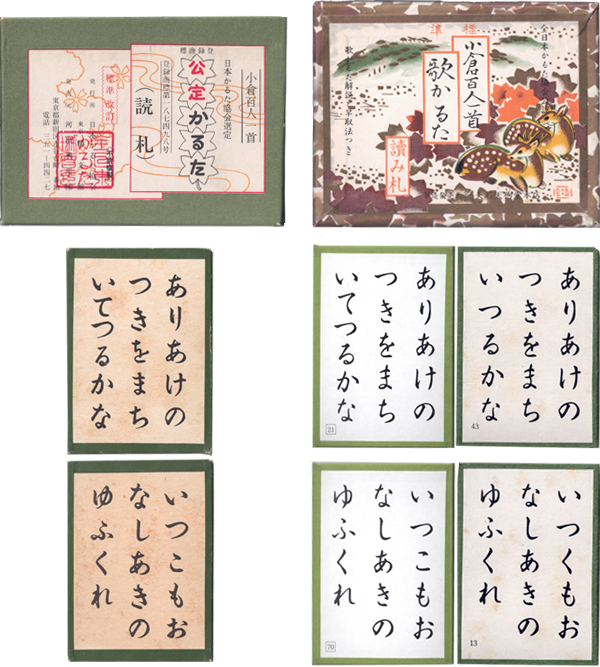
made by Kawade Kosan & Oishi Tengu-do
Later, Seibunkan (with a pattern of maple on both the front and back of the box, and a staggered pattern on the sides of the box) went out of business, and the Seibunkan business was taken over by Kawade Kosan (with the same specifications as Seibunkan for the box, and a plain back of the card). The Karuta cards produced by Kawade Kosan, perhaps due to the influence of their own "Teihon", had notations that differed from Kotei-karuta in many places.
However, Kawade Kosan also went out of business later. Therefore, in order to meet the demands of many karuta players, Oishi Tengu-do started to manufacture and sell cards for Kyogi karuta according to the traditional official karuta notation. Karuta cards manufactured before that or for purposes other than "Kyogi karuta" are written according to the "Teihon", so some Karuta cards are written differently from "Kotei-karuta".

